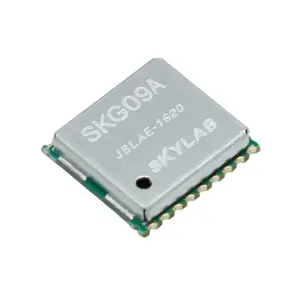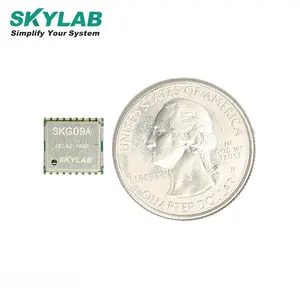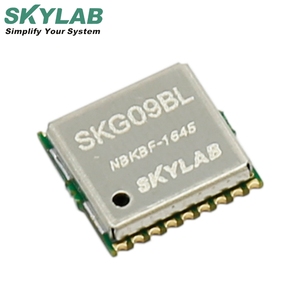Types of the Smallest GPS Tracking Chips
GPS tracking technology has evolved significantly, with modern chips becoming increasingly compact and specialized for different applications. Below are the main categories of miniature GPS tracking solutions available today:
Personal GPS Tracker Chip
These handheld or integrated chips are designed specifically for tracking individuals. They're invaluable for:
- Monitoring children's whereabouts
- Supporting elderly people with dementia
- Assisting individuals with chronic medical conditions
Beyond basic location tracking, these sophisticated devices offer:
- Heart rate monitoring capabilities
- Emergency alert systems
- Geofencing technology that creates virtual boundaries and sends alerts when crossed
Vehicle GPS Tracker Chip
Designed specifically for automotive applications, these chips provide comprehensive vehicle monitoring:
- Real-time location tracking of stolen vehicles
- Fleet management and logistics optimization
- Performance monitoring including speed tracking
- Real-time traffic information integration
- Driver behavior analysis for safety and efficiency
Asset GPS Tracker Chip
These ultra-compact tracking devices attach to valuable items and equipment:
- Monitor high-value goods during shipment
- Track equipment location in warehouses and worksites
- Provide real-time location data for lost or stolen items
- Optimal for logistics companies needing end-to-end visibility
Pet GPS Tracker Chip
Specially designed for animal tracking, these chips typically embed in collars and provide:
- Real-time location monitoring of pets
- Quick recovery of lost animals
- Activity monitoring to track exercise levels
- Health insights based on movement patterns
- Some models include temperature monitoring
GPS Tracker Chip for Children
These specialized trackers prioritize child safety with discreet form factors:
- Wearable designs like wristbands or pendants
- Smartphone integration for parent monitoring
- Emergency alert capabilities
- Location history for pattern monitoring
- Secure, tamper-resistant designs
Expert Tip: When selecting a specialized GPS tracker, consider not just the current tracking needs but also future requirements. Many modern trackers offer software updates that can add new functionality without requiring hardware replacement.
Specifications and Maintenance of the Smallest GPS Tracking Chips
The latest generation of miniature GPS tracking technology offers remarkable capabilities despite their diminutive size. Understanding their technical specifications helps in selecting the right device for specific applications.
| Specification | Details | Significance |
|---|---|---|
| Size and Weight | Approximately 10mm with 2g weight | Enables integration into small devices and applications |
| Power Consumption | Low power using advanced battery technology | Extends operational time between charges |
| Frequency Bands | L1 (1575.42 MHz) and L2 (1227.60 MHz) | L1 for civilian use, L2 for military applications |
| Tracking Accuracy | Between 5-10 meters | Precision enabled by assisted GPS and real-time kinematic technology |
| Interfaces | SPI, I2C, and UART support | Facilitates integration with various devices and systems |
| Cold Start Time | Approximately 30 seconds or less | Quick acquisition of satellite signals for fast position fix |
| Security | Encryption and authentication protocols | Prevents unauthorized access and ensures data integrity |
Essential Maintenance for GPS Tracking Devices
Regular Cleaning
Use a slightly damp cloth to gently remove dirt, dust, and other debris from the device. For device contacts or connection points, use a dry cotton swab to prevent corrosion and ensure proper connectivity.
Software Updates
Regularly check for and install firmware updates from the manufacturer. These updates often contain performance improvements, bug fixes, and new features that enhance tracking capabilities and security.
Battery and Connection Inspection
Regularly check battery levels and maintain proper charging cycles to maximize battery lifespan. Inspect all physical connections, including charging ports, SIM card slots, and external antennas for signs of wear or damage.
Important: Never expose GPS tracking chips to extreme temperatures or moisture, as these conditions can significantly damage the sensitive electronics and reduce the lifespan of the device.
How to Choose the Smallest GPS Tracking Chip
Selecting the optimal GPS tracking solution requires careful consideration of several critical factors that will determine performance, reliability, and suitability for your specific application:
Size and Form Factor
Different tracking applications have varying size requirements:
- Personal trackers need to be small enough for pocket carrying
- Vehicle trackers can be slightly larger as they're installed in fixed locations
- Pet trackers must be lightweight to avoid discomfort
- Asset trackers should be inconspicuous to prevent tampering
Always match the physical dimensions to your specific use case.
Power Consumption
Battery life is critical for many tracking applications:
- Consider devices with power-saving modes for extended use
- Evaluate the trade-off between tracking frequency and battery life
- For continuous powered applications, efficiency still matters for heat generation
- Some applications may benefit from solar or kinetic charging options
Accuracy and Reliability
Location precision requirements vary by application:
- High-value asset tracking may require sub-meter accuracy
- Pet or child tracking needs consistent, reliable performance
- Consider signal reliability in areas with obstructions
- Evaluate performance during adverse weather conditions
- Some applications benefit from multi-constellation support (GPS, GLONASS, Galileo)
Integration and Compatibility
The tracker must work seamlessly with your existing systems:
- Check hardware interface compatibility (SPI, I2C, UART)
- Verify software/API compatibility with your monitoring systems
- Consider cellular network compatibility for GSM-based trackers
- Evaluate data format compatibility with your analysis tools
Cost Considerations
Balance initial investment against performance needs:
- Factor in both acquisition cost and ongoing subscription fees
- Consider durability and replacement cycles in TCO calculations
- Evaluate battery replacement costs for non-rechargeable units
- Balance advanced features against budget constraints
- Consider volume discounts for multiple tracker deployments
Selection Tip: Before making a final decision, test the GPS tracker in the actual environment where it will be used. Signal reception can vary significantly based on physical surroundings, and real-world performance may differ from specifications.
Maintenance Best Practices for GPS Tracking Chips
Proper maintenance ensures optimal performance and extends the lifespan of your GPS tracking devices. Follow these expert recommendations for maintaining your tracking equipment:
Regular Inspection Schedule
Establish a consistent maintenance schedule based on usage conditions:
- Weekly visual inspections for heavily used devices
- Monthly functional testing for all tracking systems
- Quarterly thorough cleaning and connection checks
- Annual professional assessment for critical tracking applications
Environmental Protection
Shield your tracking devices from environmental hazards:
- Use waterproof cases in high-humidity environments
- Apply appropriate temperature insulation in extreme climates
- Consider anti-shock mounting for high-vibration applications
- Shield from direct sunlight to prevent overheating
Signal Optimization
Maintain optimal signal reception and transmission:
- Keep antennas clear of obstructions
- Check for and repair any cable damage
- Position devices for maximum sky view when possible
- Test signal strength periodically in different locations
Maintenance Warning: Never attempt to open sealed GPS tracker components as this can damage sensitive electronics and void warranties. For internal repairs, always consult with the manufacturer or an authorized service provider.
How to DIY and Replace the Smallest GPS Tracking Chip
When your GPS tracking device needs replacement, following a systematic approach ensures a smooth transition without loss of tracking capability. While specific procedures vary by manufacturer, this general guide will help you through the process:
-
Turn Off Device
Power down the old tracking device completely before beginning the replacement process. This prevents potential electrical damage and data corruption during the transition.
-
Locate the Device
Identify the exact position of the current tracker. Take photos if necessary to document the installation orientation and connection points for reference during reinstallation.
-
Remove the Old Device
Carefully detach the existing tracker following manufacturer guidelines. This may involve removing adhesive backing, unscrewing mounting brackets, or gently sliding the device from a holder.
-
Clean the Installation Area
Thoroughly clean the mounting surface with appropriate cleaning agents to remove residue, dirt, and old adhesive. Allow the surface to dry completely before proceeding.
-
Prepare the New Device
Configure your replacement tracker before physical installation: charge the battery, update firmware, and program any required settings according to manufacturer instructions.
-
Install the New Device
Mount the new tracker exactly as the previous one was positioned, ensuring all connections are secure and properly aligned. Follow manufacturer-specific mounting instructions for optimal performance.
-
Test Functionality
Verify the new tracker is working correctly by testing all critical functions: location reporting, alert systems, and connectivity with monitoring platforms. Run a movement test if applicable.
-
Properly Dispose of Old Device
Recycle the old tracker according to local electronic waste regulations. Many manufacturers offer recycling programs for their devices to ensure environmentally responsible disposal.
Installation Tip: Before completing the installation, test the new tracker in various conditions similar to its intended use environment. This helps identify any potential issues before finalizing the mounting, especially for applications where the device will be difficult to access later.
Frequently Asked Questions
No, it is not possible to track an inactive GPS chip. For location tracking to function, the device must be powered on and have access to both GPS satellite signals and a cellular network (for transmitting location data). An inactive chip cannot receive satellite signals or transmit its location information to monitoring systems.
The battery life of miniature GPS tracking chips typically ranges from 2 to 3 days before requiring recharging. However, this duration varies significantly based on several factors:
- Tracking frequency (how often position updates are sent)
- Signal strength in the usage area
- Environmental temperature (cold weather reduces battery efficiency)
- Device age (battery capacity diminishes over time)
- Whether power-saving features are enabled
Some advanced models with larger batteries or power-saving technologies can last significantly longer, while devices with continuous tracking may require daily charging.
No, using GPS tracking devices for unauthorized tracking is illegal in most jurisdictions and can result in serious legal penalties. Before using any tracking device on a person, vehicle, or property:
- Always obtain explicit consent from the individual being tracked
- For minors, ensure you have proper parental/guardian authority
- For vehicles, confirm you have legal ownership or authorization
- For employees, ensure compliance with local labor laws and provide clear disclosure
Unauthorized tracking may violate privacy laws, anti-stalking regulations, and other legislation, potentially resulting in criminal charges and civil liability.
GPS tracking chips don't have a limited "range" in the traditional sense. Instead, they work on a two-part system:
- The chip receives signals from GPS satellites to determine its location (this works anywhere with a clear view of the sky)
- The chip transmits this location data through cellular networks to tracking servers
Therefore, as long as the device has cellular coverage, it can be tracked from anywhere in the world through internet-connected tracking platforms. The only limitation is cellular network availability – in remote areas without cellular coverage, real-time tracking may not be possible.
Most miniature GPS tracking chips provide location accuracy between 5-10 meters under optimal conditions. Factors affecting accuracy include:
- Satellite visibility (buildings, trees, and tunnels can block signals)
- Atmospheric conditions
- Quality of the GPS receiver in the device
- Whether additional positioning technologies are used (A-GPS, GLONASS, etc.)
Premium tracking devices may achieve accuracy within 3 meters using advanced technologies like real-time kinematic positioning, though these typically require larger components and more power.



























































